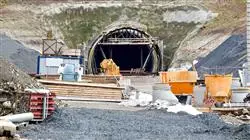University certificate
Accreditation/Membership

The world's largest faculty of engineering”
Introduction to the Program
New roads are being planned every day. That's why companies and public administrations need engineers like you to build them"

Every day, millions of people around the world use different types of roads to get around. They do so with their own vehicles or by public transportation. And each of these people has a different reason: some go to pick up their children from school, others want to go shopping. There are also those who go to a leisure activity such as the cinema or theater, or go to work. All these people depend on perfectly constructed roads to be safe and durable.
However, there are also other cases: an ambulance takes a patient to the hospital, a police car drives to a place where its presence is required, or a transport vehicle is on its route to drop off various errands, parcels and letters. Thus, roads are not just a way to get from one place to another: they are a public service on which the health and safety of the population depends.
For this reason, there is a need for highly specialized professionals who can respond to the demand of companies and public institutions that require competent personnel. Without such personnel, the roads on which most people travel would be defective and unsafe, and societies and countries would function with difficulty.
This Advanced master’s degree in Geotechnics and Road Construction responds to this demand, offering the best knowledge for engineers and professionals to become true experts in the construction of this type of roads. To this end, it combines specific knowledge in road construction and geotechnics, so that graduates have the most complete education, integrating both branches to obtain the best possible results.
Think of all the people who travel by road every day. You could help make their commute fast, safe and enjoyable"
This Advanced master’s degree in Geotechnics and Road Construction contains the most complete and up-to-date educational program on the market. The most important features include:
- The development of case studies presented by experts in civil, building and geotechnical engineering
- The graphic, schematic, and eminently practical contents with which they are created, provide scientific and practical information on the disciplines that are essential for professional practice
- Practical exercises where the self-assessment process can be carried out to improve learning
- Its special emphasis on innovative methodologies in geotechnical and road construction
- Theoretical lessons, questions to the expert, debate forums on controversial topics, and individual reflection work
- Content that is accessible from any fixed or portable device with an Internet connection
This knowledge will make you the greatest road construction expert around"
Its teaching staff includes professionals belonging to the civil engineering field, who contribute their work experience to this program, as well as renowned specialists from reference societies and prestigious universities.
The multimedia content, developed with the latest educational technology, will provide the professional with situated and contextual learning, i.e., a simulated environment that will provide an immersive training experience designed to train for real-life situations.
This program is designed around Problem-Based Learning, whereby the student must try to solve the different professional practice situations that arise during the academic program. For this purpose, the professional will be assisted by an innovative interactive video system created by renowned and experienced experts.
If you want to give your career a boost, combine the specialties of geotechnics and road construction with this Advanced master’s degree"

Geotechnics applied to road construction will lead you to master all types of projects and make every company want to count on you"
Why study at TECH?
TECH is the world’s largest online university. With an impressive catalog of more than 14,000 university programs available in 11 languages, it is positioned as a leader in employability, with a 99% job placement rate. In addition, it relies on an enormous faculty of more than 6,000 professors of the highest international renown.

Study at the world's largest online university and guarantee your professional success. The future starts at TECH”
The world’s best online university according to FORBES
The prestigious Forbes magazine, specialized in business and finance, has highlighted TECH as “the world's best online university” This is what they have recently stated in an article in their digital edition in which they echo the success story of this institution, “thanks to the academic offer it provides, the selection of its teaching staff, and an innovative learning method aimed at educating the professionals of the future”
A revolutionary study method, a cutting-edge faculty and a practical focus: the key to TECH's success.
The most complete study plans on the university scene
TECH offers the most complete study plans on the university scene, with syllabuses that cover fundamental concepts and, at the same time, the main scientific advances in their specific scientific areas. In addition, these programs are continuously being updated to guarantee students the academic vanguard and the most in-demand professional skills. In this way, the university's qualifications provide its graduates with a significant advantage to propel their careers to success.
TECH offers the most comprehensive and intensive study plans on the current university scene.
A world-class teaching staff
TECH's teaching staff is made up of more than 6,000 professors with the highest international recognition. Professors, researchers and top executives of multinational companies, including Isaiah Covington, performance coach of the Boston Celtics; Magda Romanska, principal investigator at Harvard MetaLAB; Ignacio Wistumba, chairman of the department of translational molecular pathology at MD Anderson Cancer Center; and D.W. Pine, creative director of TIME magazine, among others.
Internationally renowned experts, specialized in different branches of Health, Technology, Communication and Business, form part of the TECH faculty.
A unique learning method
TECH is the first university to use Relearning in all its programs. It is the best online learning methodology, accredited with international teaching quality certifications, provided by prestigious educational agencies. In addition, this disruptive educational model is complemented with the “Case Method”, thereby setting up a unique online teaching strategy. Innovative teaching resources are also implemented, including detailed videos, infographics and interactive summaries.
TECH combines Relearning and the Case Method in all its university programs to guarantee excellent theoretical and practical learning, studying whenever and wherever you want.
The world's largest online university
TECH is the world’s largest online university. We are the largest educational institution, with the best and widest online educational catalog, one hundred percent online and covering the vast majority of areas of knowledge. We offer a large selection of our own degrees and accredited online undergraduate and postgraduate degrees. In total, more than 14,000 university degrees, in eleven different languages, make us the largest educational largest in the world.
TECH has the world's most extensive catalog of academic and official programs, available in more than 11 languages.
Google Premier Partner
The American technology giant has awarded TECH the Google Google Premier Partner badge. This award, which is only available to 3% of the world's companies, highlights the efficient, flexible and tailored experience that this university provides to students. The recognition as a Google Premier Partner not only accredits the maximum rigor, performance and investment in TECH's digital infrastructures, but also places this university as one of the world's leading technology companies.
Google has positioned TECH in the top 3% of the world's most important technology companies by awarding it its Google Premier Partner badge.
The official online university of the NBA
TECH is the official online university of the NBA. Thanks to our agreement with the biggest league in basketball, we offer our students exclusive university programs, as well as a wide variety of educational resources focused on the business of the league and other areas of the sports industry. Each program is made up of a uniquely designed syllabus and features exceptional guest hosts: professionals with a distinguished sports background who will offer their expertise on the most relevant topics.
TECH has been selected by the NBA, the world's top basketball league, as its official online university.
The top-rated university by its students
Students have positioned TECH as the world's top-rated university on the main review websites, with a highest rating of 4.9 out of 5, obtained from more than 1,000 reviews. These results consolidate TECH as the benchmark university institution at an international level, reflecting the excellence and positive impact of its educational model.” reflecting the excellence and positive impact of its educational model.”
TECH is the world’s top-rated university by its students.
Leaders in employability
TECH has managed to become the leading university in employability. 99% of its students obtain jobs in the academic field they have studied, within one year of completing any of the university's programs. A similar number achieve immediate career enhancement. All this thanks to a study methodology that bases its effectiveness on the acquisition of practical skills, which are absolutely necessary for professional development.
99% of TECH graduates find a job within a year of completing their studies.
Advanced Master's Degree in Geotechnics and Road Construction
.
Roads are one of the most important transportation routes to carry out many of the activities of our daily lives, from commuting to our places of study and work, to the transportation of food. These are indispensable aspects that, if they could not be carried out, would compromise the functioning and stability of the social, economic and cultural fabric of the different countries. In short, public roads are an absolutely necessary service that requires trained professionals for their proper construction and maintenance. Bearing in mind that this is a highly complex task, and that it depends on many factors to which a complete and specific education can contribute, at TECH Global University we have developed the Advanced Master's Degree in Geotechnics and Road Construction. Through a complete and updated program that offers all the necessary knowledge to specialize with guarantees, you will take a definitive step to ensure a successful future in this field of engineering, an area that demands quality personnel to build the roads of the present and the future.
Specialize in geotechnics and foundations
.
Hand in hand with innovative methodologies, the accompaniment of experts in the area and a curriculum designed with the highest academic rigor, you will acquire and perfect skills that will allow you to achieve your professional goals in the field of geotechnics and road construction. Thus, you will be able to identify the major differences between the dynamic and static behavior of soils and rocks, define the appropriate techniques for each building project, and learn in detail the factors that affect the safety and comfort of the road, the parameters that measure it and the possible actions for its correction. This program stands out as a novel, complete and effective opportunity to boost the growth of your professional profile, get certified now in the largest Faculty of Engineering!







